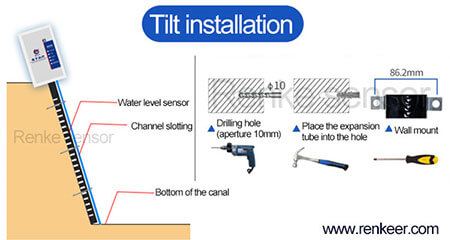
The simplest and oldest industrial signal communication is 4-20 mA current loops (where the loop current varies with the level measurement) are the most common output mechanism today. Analog voltages are simple to setup and deal with, but may have serious noise and interference issues. Useful transducer output signal formats for computer automation are current loops, analog voltages and digital signals. This requires sending data in a machine-readable format from the sensor to the control or monitoring system. When more complex physical principles are involved, emerging technologies often use computers to perform the calculations.

Hydrostatic head measurements have also been widely used to infer level. A simple float having a specific gravity between those of the process fluid and the headspace vapor will float at the surface, accurately following its rises and falls. Other level-detection devices include those based on specific gravity, the physical property most commonly used to sense the level surface. They are therefore being rapidly replaced by more advanced technologies. It can be stated without reservation that conventional sight glasses are the weakest link of any installation. Seals are prone to leak, and buildup, if present, obscures the visible level. The material used for its transparency can suffer catastrophic failure, with ensuing environmental insult, hazardous conditions for personnel, and/or fire and explosion.
Water depth gauge manual#
A manual approach to measurement, sight glasses have always had a number of limitations. Two weeks ago I was idling forward at 2' depth of water, next to friends 2002 Bu Direct Drive.his depth gauge that has always worked showed between 1.5 to 2' back to the ramp.my just blinked at 6.5 the whole way in.The simplest and oldest industrial level measurement device is, of course, the sight glass. If just sitting or idle forward at slow speed in shallow water (anything less than 8' on my boat).it just blinks at the last know reading - say 6.5 feet.but if you accelerate and get the nose way up, it will sometimes read correctly.like all the sudden 4.2 feet.drop the nose back down and it quits reading correctly 's like the sonar (or what ever it is) is not aiming correctly at the bottom of the lake? Or maybe loose wiring, or one of the weird ohm things? This last time out, I noticed one other very strange thing about it that I have not noticed before: I still do not have a fix, and have no clue as to what is going on? I don't like it, cause it is not safe in shallow waters. Twice this last weekend got stuck on a sand bar.friends pushed the boat off.but the depth gauge was blinking at 6.5 feet.which means that was the last accurate reading it got! Naturally, this is something else that needs to be fixed. How is it that a depth gauge works anyway? Is it two beams of something converging on the bottom of the lake? Or bounce back? or what? Anyone have an idea what the problem is?ģ. Is this part (the depth gauge) plug and play? OR do you have to rewire the boat to replace it?Ģ. Which is a real pain if you are in unfamiliar waters.ġ.

It will never work in any thing less than 6 feet.

But sense about January of the this year it does not work in depths of less than 10 feet or so.įor example you may be out in 40 feet of water, come into shore and somewhere it in water depth of 6-10 feet, it will lock and start blinking, which means it is not will not work again until you get back out into deep water again. Up until about last December, the depth gauge always worked perfect in all conditions.


 0 kommentar(er)
0 kommentar(er)
